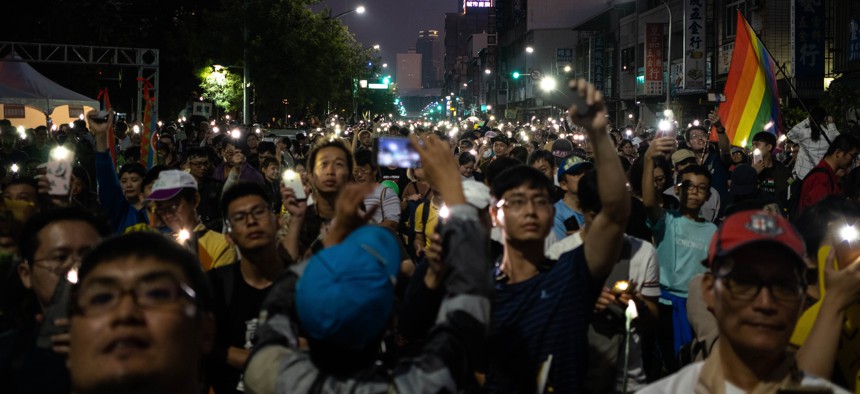PATRICK TUCKER

Many U.S. observers are waiting in dread for China to attempt a military takeover of Taiwan sometime before 2027, but beneath the threshold of armed conflict, China is already attacking vital Taiwanese information streams, both physically and virtually, while the island develops new tools and techniques to resist.
In April, a Chinese fishing vessel, followed by a cargo ship, dragged their anchors east of Taiwan’s Matsu islands, severing the two communications cables that link the islands with Taiwan itself, an act of either sabotage or clumsiness that has occurred at least 27 times in just the last five years. Taiwan has said that it suspects the severings were intentional. And of course attacks on commercial and public telecommunications channels are now a common occurrence between adversarial nations, as when Russia attacked the U.S.-based satellite communications company Viasat an hour before Moscow launched its renewed war on Ukraine.
The Taiwanese government took the interruption as an opportunity to help citizens develop workarounds to continuous Chinese-caused, er, service interruptions.
“We took that as a chance to not just teach people about, you know, microwave, and also satellite [communications] backup and things like that; we also saw a lot of civil society start learning about how to set up emergency communications when the bandwidth is limited.” Audrey Tang, Taiwan’s minister of digital affairs, told audiences during the Special Competitive Studies Project Summit in Washington, D.C. on Thursday.
But various Chinese-backed actors also regularly target the Taiwanese population with coordinated messaging and influence campaigns. A 2019 report from cybersecurity company Record Future found that the Chinese government employs as many as half a million people to sway opinions on social media at home and around the world.
As Taiwan approaches a pivotal presidential election in January, Tang said that both the government and a wide network of volunteers are preparing for China to increase efforts to manipulate Taiwanese civilians. Taiwanese civil society has developed new organizations to combat it. A group called Cofacts allows users to forward dubious messages to a chatbot. Human editors check the messages, enter them into a database, and get back to the user with a verdict.
The number of volunteers to man the service and others like are few compared to the size of China’s efforts, said Tang. “The people who actually do … foreign interference nowadays coordinated with cyber attack have a lot of resources,” she said.
Enter generative AI tools such as large language models, which power some of the big breakthrough online AI tools such as ChatGPT. “This year, because gen AI is just so mailable, they just fine-tuned a language module together that can clarify such disinformation…adding back a context and things like that. So we're no longer outnumbered,” she said. It also allows the citizen-run venture to remain as such, as opposed to run by the government, which is important for its credibility. “It doesn't need dedicated hardware or resources and can be done on laptops. It is still squarely in the social sector by volunteers, which is the best place to be so that it will not be captured by any state or a capitalist apparatus.”
The U.S. intelligence community is also looking at how it can use generative artificial intelligence to raise productivity, Avril Haines, the Director of National Intelligence, said during the summit.
“We have a program called the Unity program that's supposed to do just that. It's actually focused on artificial intelligence and it's supposed to help us take the best practices and then scale them and fund the scaling to some extent,” Haines said.
But she said the United States has much more work to do to understand both the development ecosystem for such tools that are rooted in private companies and better detect how adversaries will use generative AI to attack the United States.
Haines said One fear, she said, is that new tools like generative AI are so powerful that small nations or non-state actors will be able to use them to great effect to rival the capabilities of much larger, more predictable adversaries like China. “The state actors that we typically focus on are also, yes, going to be part of what we're going to be looking at in terms of the threat. But if you've got something that's cheaply available, that's commercially available, you might also see other state actors that typically would not be engaging in these kinds of threats doing so more because it's more available to them,” she said.
No comments:
Post a Comment